Design and Development of Supersonic Shockwave Soil-Loosening Device That Can Improve the Aeration of Crop Root Zone
Abstract
Featured Application
Abstract
1. Introduction
2. System Design and Development
2.1. System Architecture
- (1)
- Shockwave generator: This is a supersonic shockwave-generating device. It allows users to adjust the volume and pressure of the device’s storage tank.
- (2)
- Activator: This is a solenoid valve that starts the shockwave generator to generate supersonic shockwaves. The monitoring host can control the solenoid valve.
- (3)
- Air source: It can supply the high-pressure gas required for the shockwave generator’s storage tank. An air source can be a high-pressure gas cylinder or an air compressor.
- (4)
- Regulator: It can adjust the gas pressure of the shockwave generator’s storage tank.
- (5)
- Input pressure gauge: It can display the gas pressure of the shockwave generator’s storage tank.
- (6)
- Inlet valve: This valve controls the gas flow from the gas source into the shockwave generator’s storage tank.
- (7)
- Volume adjuster: It can adjust the volume of the shockwave generator’s storage tank by changing its piston position.
- (8)
- Tank pressure detector: This is a PM20C gas pressure sensor (spt) [23] used to detect the pressure of the storage tank. The maximum pressure of each detector is 1 MPa. The signal transformation unit can send the detected pressure signal (pt) to the monitoring host for processing.
- (9)
- Shock tube: The shockwaves generated by the generator first enter the shock tube, which uses gas to transmit high-pressure shockwaves.
- (10)
- Output pressure gauge: This is a legacy mechanical pressure gauge installed on the shock tube to indicate its maximum pressure.
- (11)
- Output pressure detector: This is a Model 113B23 high-pressure and high-speed pressure sensor (spo) [24]. The maximum pressure of the detector is 103.42 MPa. It can detect the shockwave pressure output to the shock tube. The signal transformation unit can send the detected pressure signal (po) to the monitoring host for processing.
- (12)
- Outlet valve: This is a control valve that can transmit high-pressure shockwaves from the shock tube. The transmitted high-pressure shockwaves can be sent to the drilling unit’s shock output tube through the high-pressure hose for injection output.
- (13)
- Exhaust valve: This is a control valve used to discharge the high-pressure gas accumulated in the shock tube.
- (14)
- Drilling unit: It mainly comprises a charging motor, a reducer, and a rotary joint and drives the shock output tube to complete the earth drilling work.
- (15)
- Shock output tube: This is a hollow stainless steel spiral output tube (drill bit). There are many holes drilled around the output tube. When the output tube is drilled into the soil to a predetermined depth, the shockwaves generated by the shockwave generator can be directly ejected from these holes to loosen soil at the crop roots. As shown in Figure 2, the length of the shock output tube is d, the distance between the uppermost output hole and the soil surface is d1, the depth covered by the shock output holes is d2, and the depth below the output holes is d3.
- (16)
- Soil pressure detectors 1 − n: They are UBX-100 kg pressure sensors [25] (sp1, sp2, …, spm, m in total) installed around the shock output tube in the soil. The maximum pressure of each detector is 10 MPa. They can detect the impact pressure emitted by the shock output tube on the soil. The detected pressure signals (ps1, ps2, …, psm) can be transmitted to the monitoring host through the signal transformation unit for processing.
- (17)
- Signal transformation unit: This is an NI USB-6351 multi-function data acquisition card [26], which has 16 analog input (AI) channels, 2 analog output (AO) channels, and 24 programmable digital input/output (DIO) channels. The sampling rate of multiple AI channels is 1.00 MS/s. This data acquisition card can activate the shockwave generator to generate high-pressure shockwaves through one DO channel and capture the signals of the tank pressure, output pressure, and soil pressures through six AI channels.
- (18)
- Monitoring host: This is a personal computer with Microsoft Windows 11. It can execute the self-developed LabVIEW software to measure shockwave soil loosening automatically. The monitoring host can use the buffered sampling function provided by the NI USB-6351 data acquisition card to automatically and quickly capture tank pressure, output pressure, and soil pressures from the designated AI channels according to the set sampling rate and number of sampling points. The measurement data are stored in the buffer of the acquisition card, and then, the monitoring host further records and draws the curves of various parameter data for users to analyze the effectiveness of shockwave soil loosening.
2.2. Physical Development of the Shockwave-Loosening Device
2.3. Design and Development of the Shock Output Tube
3. Numerical Simulation of Shockwave Soil Loosening
3.1. Governing Equations and the Preconditioning System
3.2. Assumptions
- Shockwave characteristics: The initial shockwave was generated with a pressure of 10 atm (about 1000 kPa) at the shock tube inlet, simulating the shockwave start-pressure of the system.
- Soil model: The soil was modeled as a porous medium with specific properties, including a density of 1500 kg/m3 and a porosity of 30%.
- Boundary conditions: The shock tube inlet was set as a pressure inlet with an initial high-pressure patch, while the far-field boundaries were defined as pressure outlets to minimize reflections.
3.3. Results and Observations
4. Visual Observation Experiments of Soil Loosening by Shockwaves
5. Pressure Measurement Experiments for Shockwave Impact
6. Analysis of Pressure Measurement Experiments
7. Conclusions
8. Patents
Author Contributions
Funding
Institutional Review Board Statement
Informed Consent Statement
Data Availability Statement
Acknowledgments
Conflicts of Interest
References
- McNear, D.H., Jr. The Rhizosphere: Roots, Soil and Everything in Between. Nat. Educ. Knowl. 2013, 4, 1. [Google Scholar]
- Lazarovitch, N.; Vanderborght, J.; Jin, Y.; Van Genuchten, M.T. The Root Zone: Soil Physics and Beyond. Vadose Zone J. 2018, 17, 1–6. [Google Scholar] [CrossRef]
- Wesseling, J.; van Wijk, W.R. Soil physical conditions in relation to drain depth. Drain. Agric. Lands 1957, 7, 461–504. [Google Scholar]
- Lin, Y.Z.; Chen, B.H.; Cai, Y.P. Citrus Growth and Cultivation Management; Special Issue No. 175; Agricultural Research Institute, Council of Agriculture: Taichung, Taiwan, 2013. [Google Scholar]
- Guo, Y.G. Soil. In Introduction to Agriculture; Shen, Z.M., Ed.; National Chiayi University: Chiayi, Taiwan, 2007; pp. 69–78. [Google Scholar]
- Bhattarai, S.P.; Pendergast, L.; Midmore, D.J. Root aeration improves yield and water use efficiency of tomato in heavy clay and saline soils. Sci. Hortic. 2006, 108, 278–288. [Google Scholar] [CrossRef]
- Ben-Noah, I.; Friedman, S.P. Review and evaluation of root respiration and of natural and agricultural processes of soil aeration. Vadose Zone J. 2018, 17, 170119. [Google Scholar] [CrossRef]
- Abuarab, M.; Mostafa, E.; Ibrahim, M. Effect of air injection under subsurface drip irrigation on yield and water use efficiency of corn in a sandy clay loam soil. J. Adv. Res. 2013, 4, 493–499. [Google Scholar] [CrossRef] [PubMed]
- Ben-Noah, I.; Fredman, S.P. Aeration of clayey soils by injecting air through subsurface drippers: Lysimetric and field experiments. Agric. Water Manag. 2016, 176, 222–233. [Google Scholar] [CrossRef]
- Niu, W.Q.; Fan, W.T.; Persaud, N.; Zhou, X.B. Effect of Post-Irrigation Aeration on Growth and Quality of Greenhouse Cucumber. Pedophere 2013, 23, 790–798. [Google Scholar] [CrossRef]
- Li, J.F.; Zheng, D.Y.; Chang, B.C.; Jiang, Y.L. Improving Soil Aeration by water jet to restore the tree vigor of Pomelo. J. Taiwan Soc. Hort. Sci. 2018, 64, 269–277. [Google Scholar]
- Chen, K.Z. Nutritional Diagnosis and Fertilization of Fruit Trees; Xu Style Cultural and Educational Foundation: Berlin, Germany, 1992. [Google Scholar]
- Zhu, Y.Z.; Li, Z.H.; Yang, Z.W.; Huang, W.D. Effects of Permaculture on Soil Organic Carbon Pools. J. Weed Soc. Repub. China 2018, 39, 85–96. [Google Scholar]
- Reicosky, D. Tillage-induced CO2 emission from soil. Nutr. Cycl. Agroecosyst. 1997, 49, 273–285. [Google Scholar] [CrossRef]
- Mühlbachová, G.; Růžek, P.; Kusá, H.; Vavera, R. CO2 emissions from soils under different tillage practices and weather conditions. Agronomy 2023, 13, 3084. [Google Scholar] [CrossRef]
- Li, Z.; Zhang, Q.; Li, Z.; Qiao, Y.; Du, K.; Yue, Z.; Tian, C.; Leng, P.; Cheng, H.; Chen, G.; et al. Responses of soil CO2 emissions to tillage practices in a wheat maize cropping system: A 4-year field study. Field Crops Res. 2023, 294, 108832. [Google Scholar] [CrossRef]
- Jones, O.R.; Hauser, V.L.; Popham, T.W. No-tillage effects on infiltration and water conservation on dryland. Trans. ASAE 1994, 37, 473–479. [Google Scholar] [CrossRef]
- Ben-Dor, G. Shockwave Reflections Phenomena; Springer: New York, NY, USA, 1991. [Google Scholar]
- Wen, C.Y. Pilot Supersonic Combustion Ramjet Engine Research Project (II); Achievements Report on the Special Research Program of the National Science Council; NSC 99-2623-E-006-010-D; National Science Council: Taipei, Taiwan, 2011.
- Hu, M.S.; Su, R.H. Generating Device for Supersonic Shock Waves. R.O.C. New Patent M553377, 21 December 2017. [Google Scholar]
- Hu, M.S.; Hsu, U.K. Design of a New Supersonic Shock Wave Generator and Application in Power Generation. Appl. Sci. 2024, 14, 5074. [Google Scholar] [CrossRef]
- Hu, M.S.; Tsai, J.Y. The Application of Supersonic Shock Waves in Removing Pipeline Obstructions. J. Air Force Inst. Technol. 2024, 23, 23–32. [Google Scholar]
- Ceramic Pressure Transmitter, Type: PM20C. Available online: https://www.fullwins.com.tw/uploadfiles/38/ftp/pdf/pm20c_c.pdf (accessed on 21 February 2025).
- Model 113B23, ICP® Pressure Sensor Installation and Operating Manual, PCB Piezotronics, Inc. Available online: https://www.pcb.com/contentstore/docs/PCB_Corporate/Pressure/Products/Manuals/113B23.pdf (accessed on 2 February 2025).
- Long Strip Load Cell, UBX-100kg, CHUNDE. Available online: https://www.chunde.com.tw/pdf/19374/UBA%20%20UBX%20%20UBAX.pdf (accessed on 21 February 2025).
- NI USB-6351, X Series Multifunction DAQ (16AI, 24DIO, 2AO), 1.25MS/s Single-Channel Sampling Rate, National Instruments. Available online: https://www.ni.com/docs/zh-TW/bundle/pcie-usb-6351-specs/page/specs.html (accessed on 2 February 2025).
- Liou, M.S. A Continuing Search for a Near-Perfect Numerical Flux Scheme, Part I: AUSM+, NASA TM 106524; NASA: Washington, DC, USA, March 1994.
- Choi, Y.H.; Merkle, C.L. The application of preconditioning in viscous flows. J. Comput. Phys. 1993, 105, 207–233. [Google Scholar] [CrossRef]
- Weiss, J.M.; Smith, W.A. Preconditioning applied to variable and constant density flows. AIAA J. 1995, 33, 2050–2057. [Google Scholar] [CrossRef]
- Hsu, U.K.; Tai, C.H.; Tsai, C.H. All Speed and High-Resolution Scheme Applied to Three-Dimensional Multi-Block Complex Flowfield System. Chin. J. Mech. Ser. A 2004, 20, 21–33. [Google Scholar] [CrossRef]
- Hsiao, T.C.; Wang, C.Y.; Chu, J.W. Virtual Instrument Control Programming—LabVIEW 201X; Gao Li Book Corp.: New Taipei, Taiwan, 2014. [Google Scholar]
- Chen, C.C. LabVIEW Applications (Include Automatic Measurement and Remote Control); Gao Li Book Corp. Ltd.: New Taipei, Taiwan, 2014. [Google Scholar]
- Hsu, Y.H. Interface Design and Practice—Using LabVIEW; Chuan Yua Book Corp. Ltd.: Taipei, Taiwan, 2014. [Google Scholar]

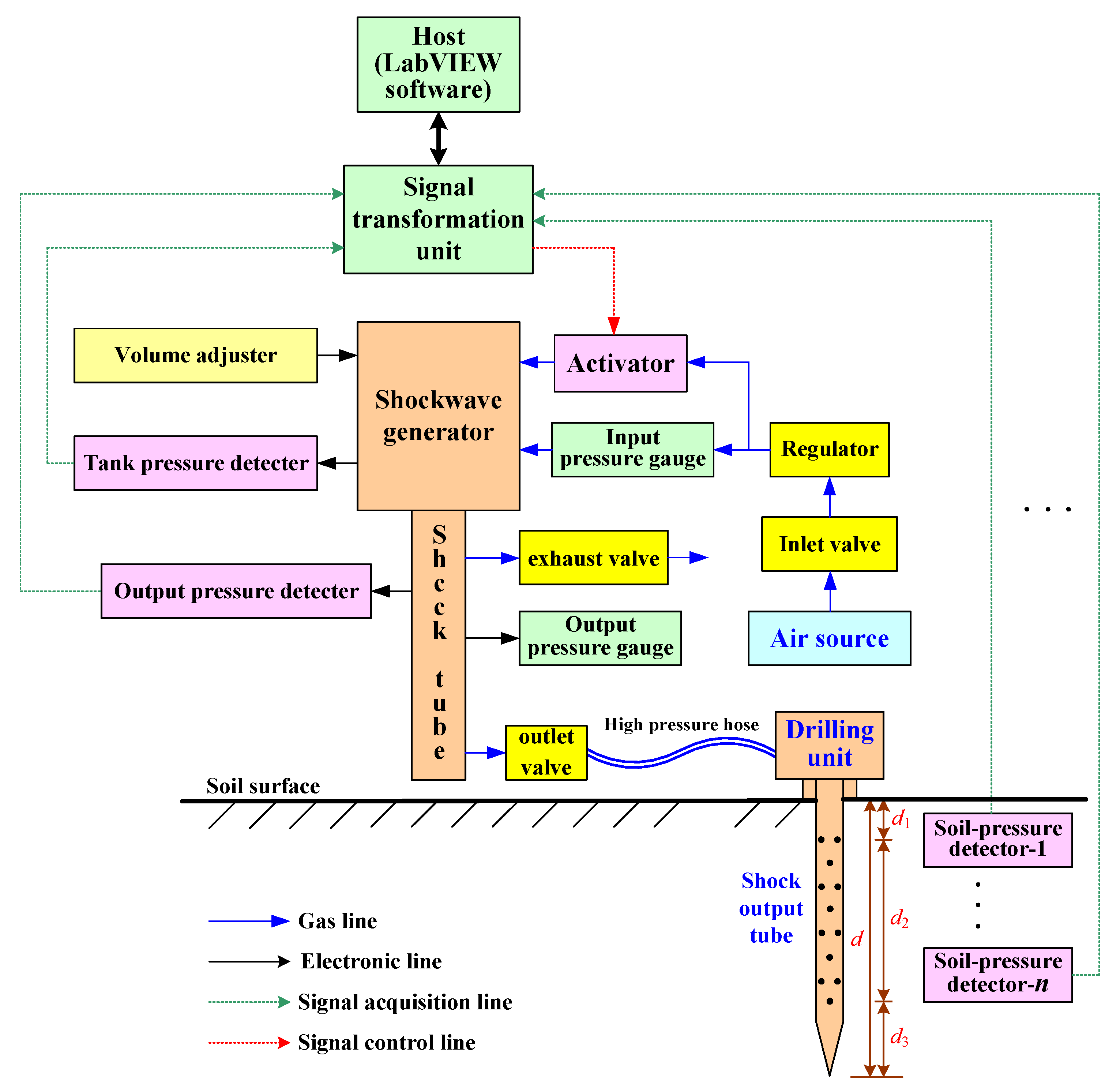
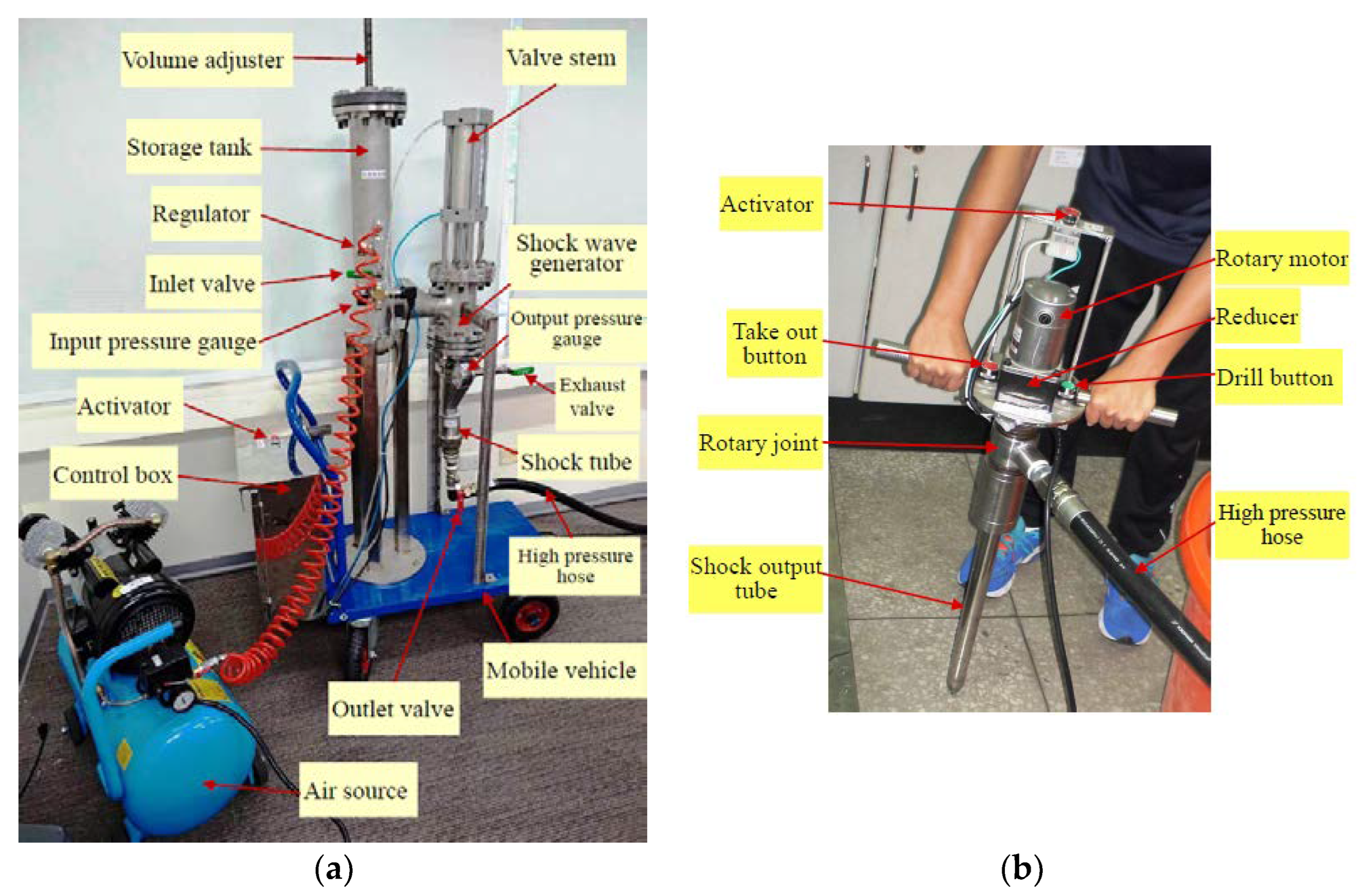
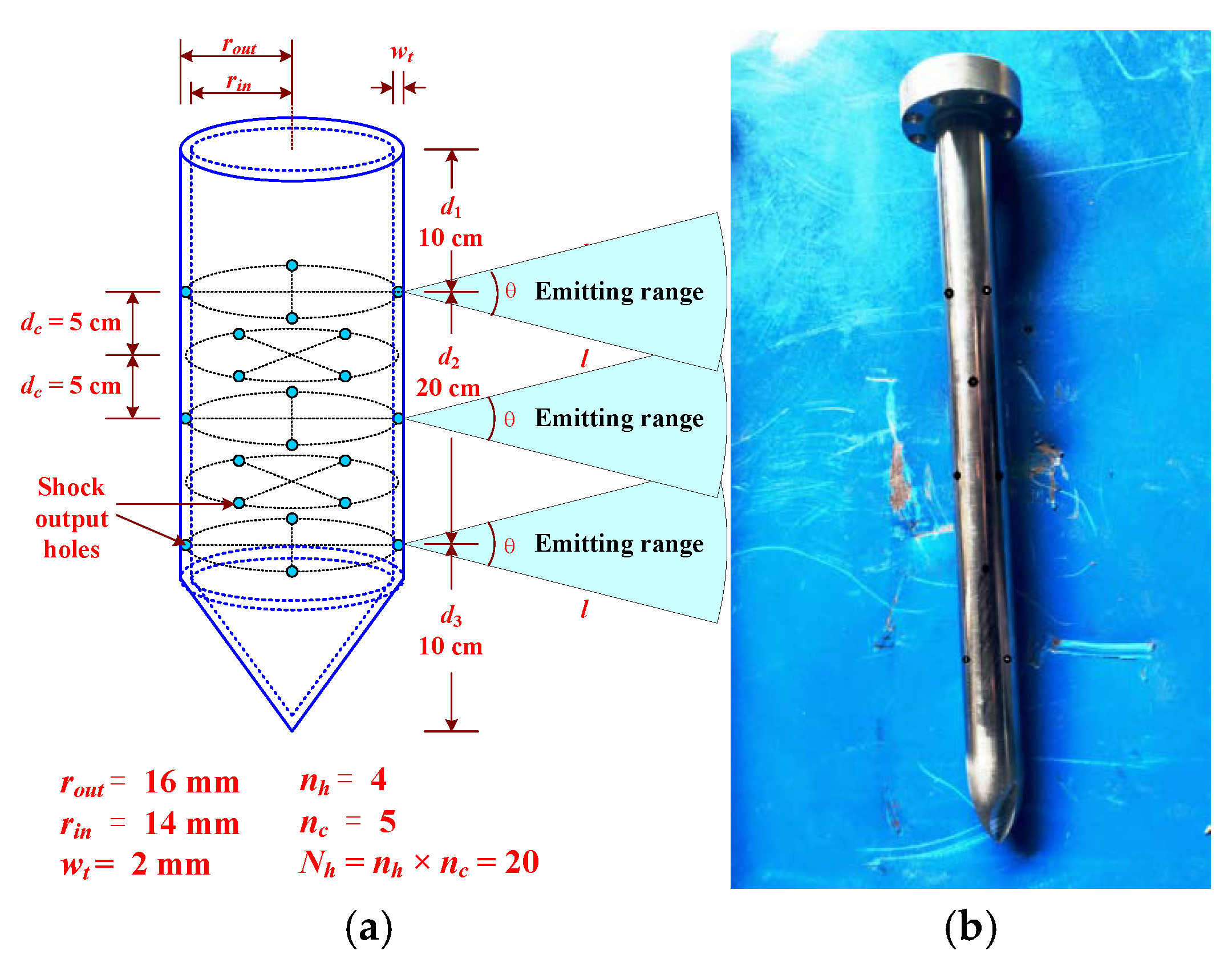
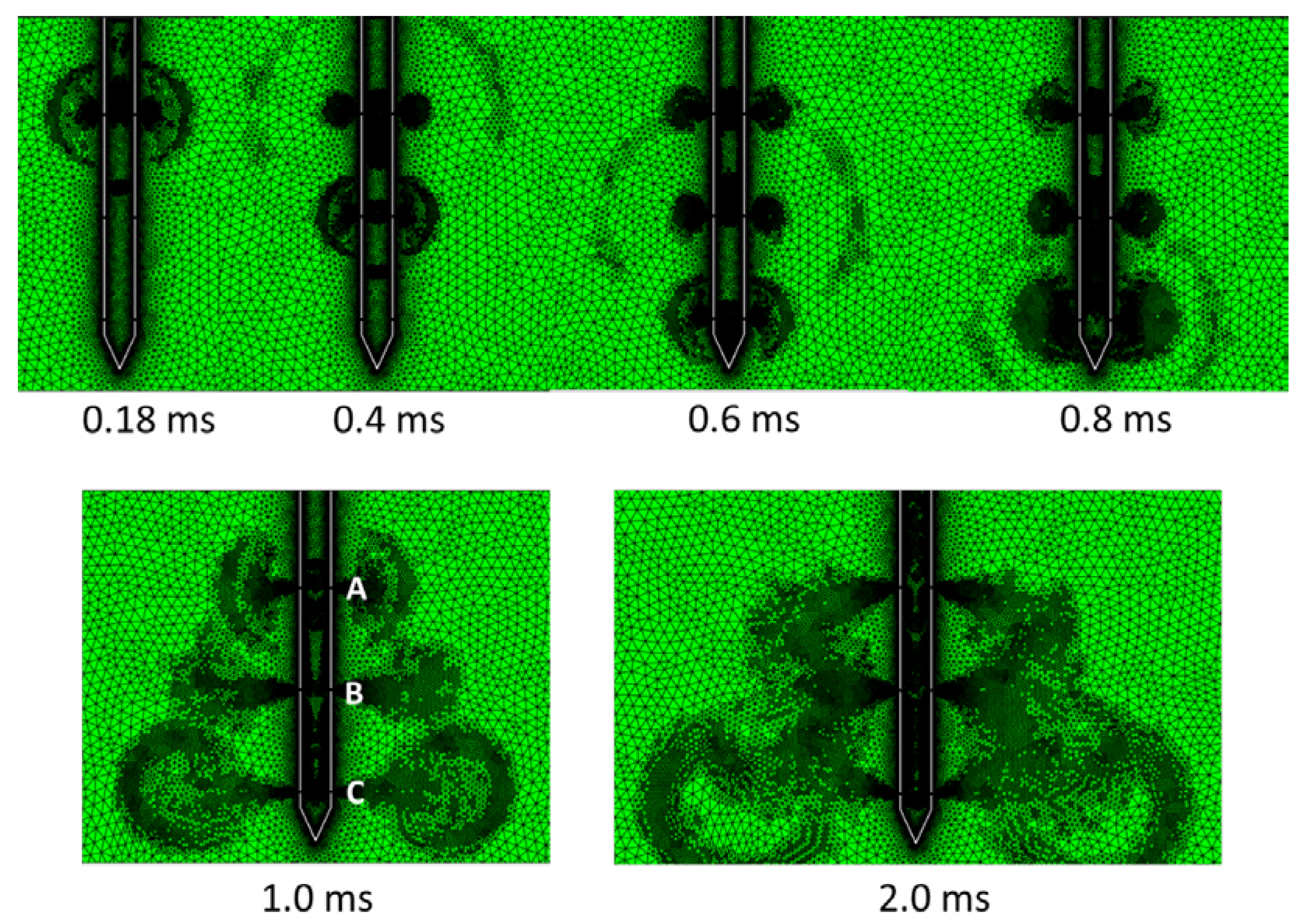
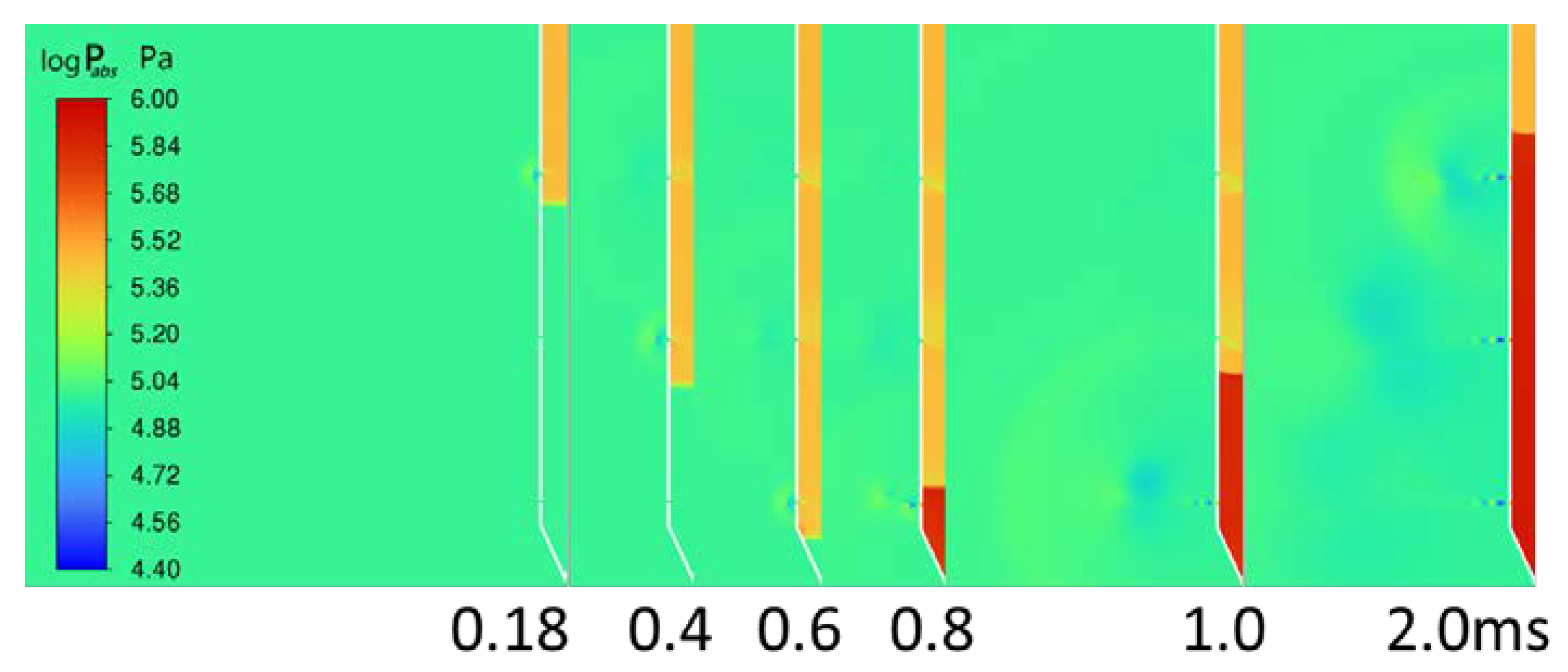


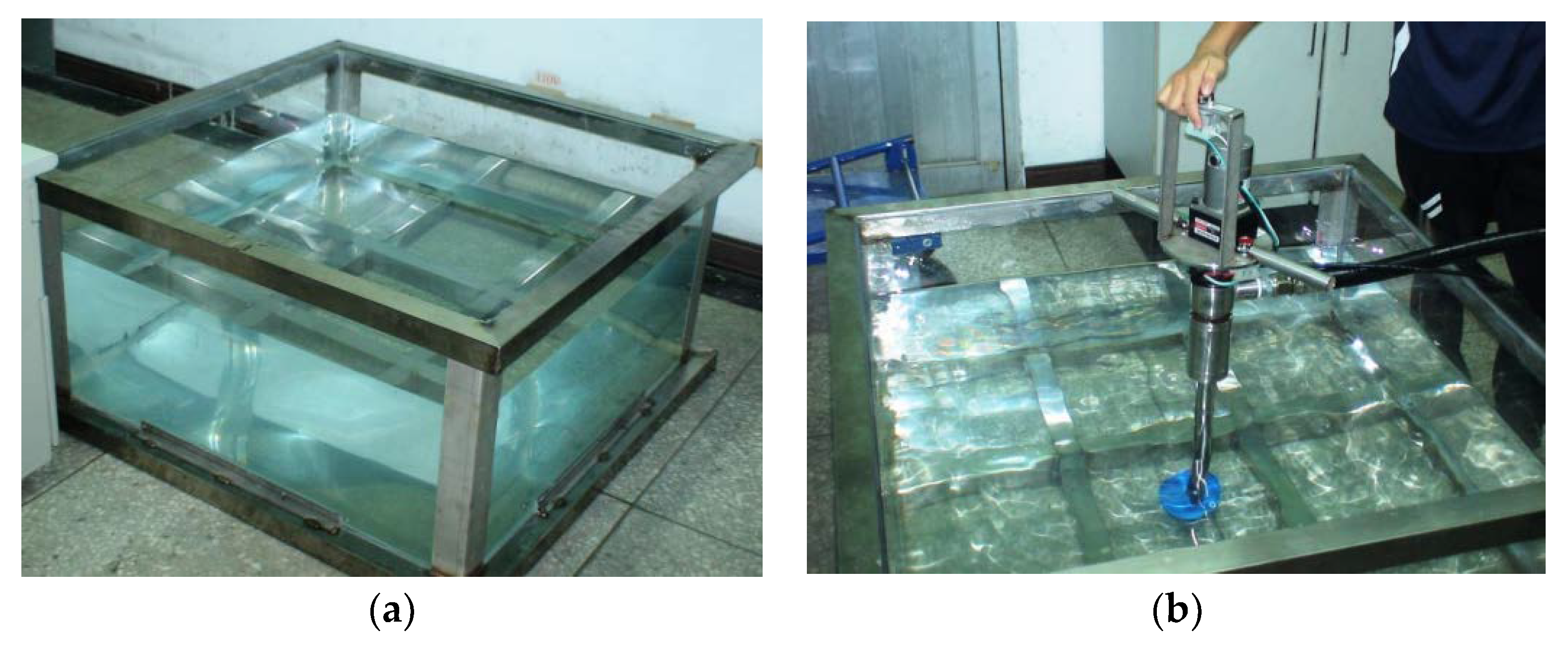
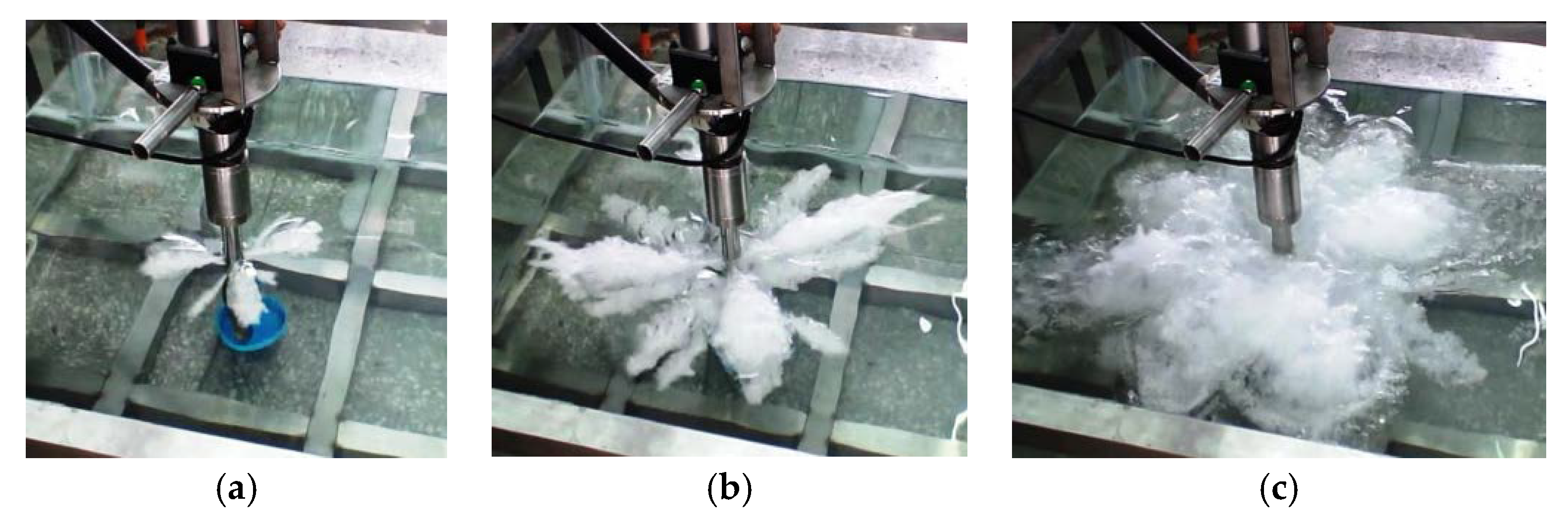

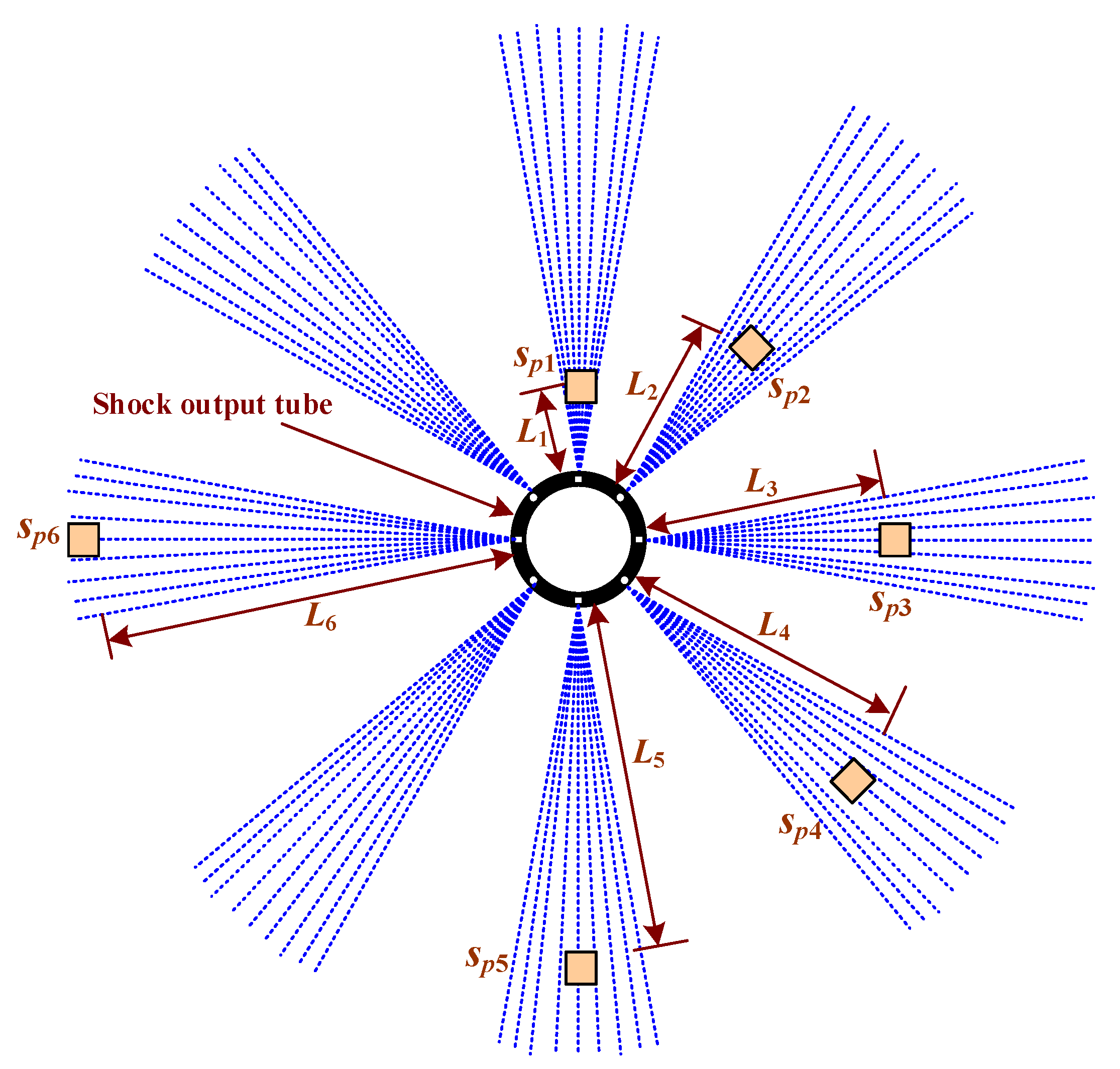
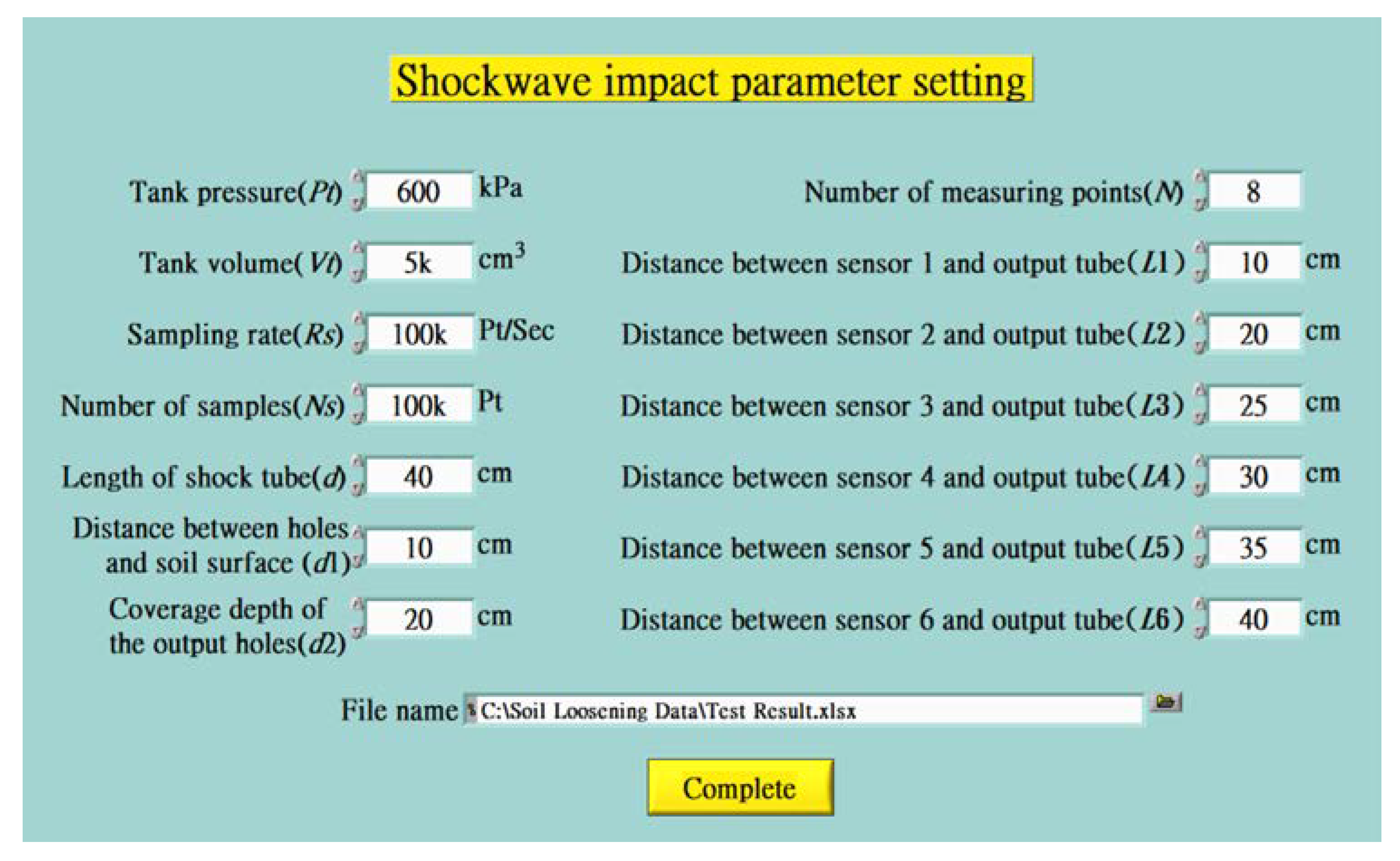
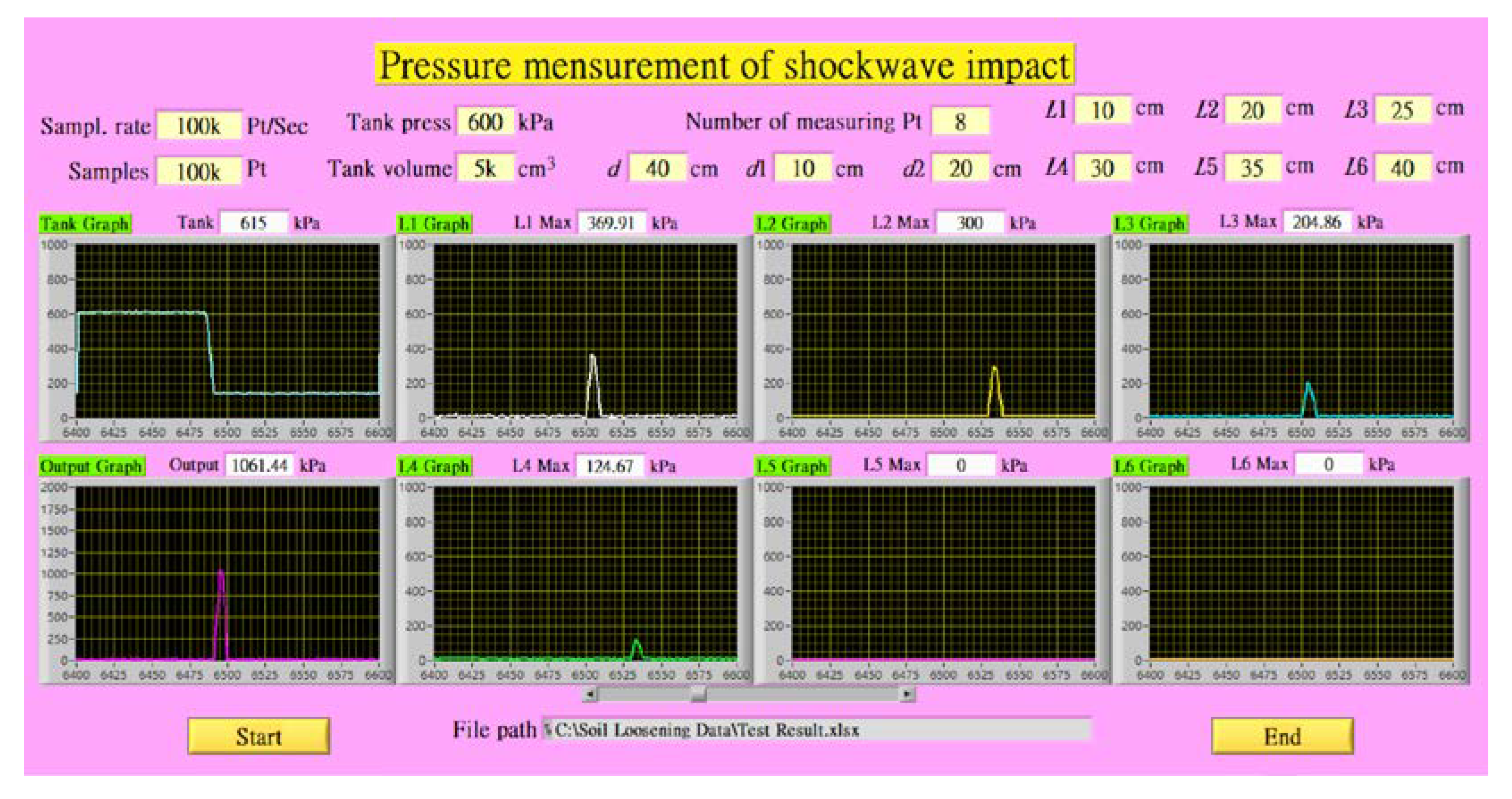
| Test | Vt | Pt | pomax | ps1max | ps2max | ps3max | ps4max | ps5max | ps6max | demax |
|---|---|---|---|---|---|---|---|---|---|---|
| (cm3) | (kPa) | (kPa) | (kPa) | (kPa) | (kPa) | (kPa) | (kPa) | (kPa) | (cm) | |
| 1 | 3000 | 400 | 824.3 | 226.4 | 165.2 | 65.8 | 0 | 0 | 0 | 25 |
| 2 | 3000 | 600 | 865.8 | 273.6 | 182.4 | 92.5 | 0 | 0 | 0 | 25 |
| 3 | 5000 | 400 | 1036.3 | 342.4 | 263.6 | 186.7 | 96.8 | 0 | 0 | 30 |
| 4 | 5000 | 600 | 1161.4 | 369.9 | 317.7 | 204.9 | 124.9 | 0 | 0 | 30 |
Disclaimer/Publisher’s Note: The statements, opinions and data contained in all publications are solely those of the individual author(s) and contributor(s) and not of MDPI and/or the editor(s). MDPI and/or the editor(s) disclaim responsibility for any injury to people or property resulting from any ideas, methods, instructions or products referred to in the content. |
© 2025 by the authors. Licensee MDPI, Basel, Switzerland. This article is an open access article distributed under the terms and conditions of the Creative Commons Attribution (CC BY) license (https://creativecommons.org/licenses/by/4.0/).
Share and Cite
Hu, M.-S.; Hsu, U.-K.; Tsai, S.-H.; Lee, C.-H. Design and Development of Supersonic Shockwave Soil-Loosening Device That Can Improve the Aeration of Crop Root Zone. Appl. Sci. 2025, 15, 2714. https://doi.org/10.3390/app15052714
Hu M-S, Hsu U-K, Tsai S-H, Lee C-H. Design and Development of Supersonic Shockwave Soil-Loosening Device That Can Improve the Aeration of Crop Root Zone. Applied Sciences. 2025; 15(5):2714. https://doi.org/10.3390/app15052714
Chicago/Turabian StyleHu, Ming-Sen, Uzu-Kuei Hsu, Shang-Han Tsai, and Chia-Hsing Lee. 2025. "Design and Development of Supersonic Shockwave Soil-Loosening Device That Can Improve the Aeration of Crop Root Zone" Applied Sciences 15, no. 5: 2714. https://doi.org/10.3390/app15052714
APA StyleHu, M.-S., Hsu, U.-K., Tsai, S.-H., & Lee, C.-H. (2025). Design and Development of Supersonic Shockwave Soil-Loosening Device That Can Improve the Aeration of Crop Root Zone. Applied Sciences, 15(5), 2714. https://doi.org/10.3390/app15052714





